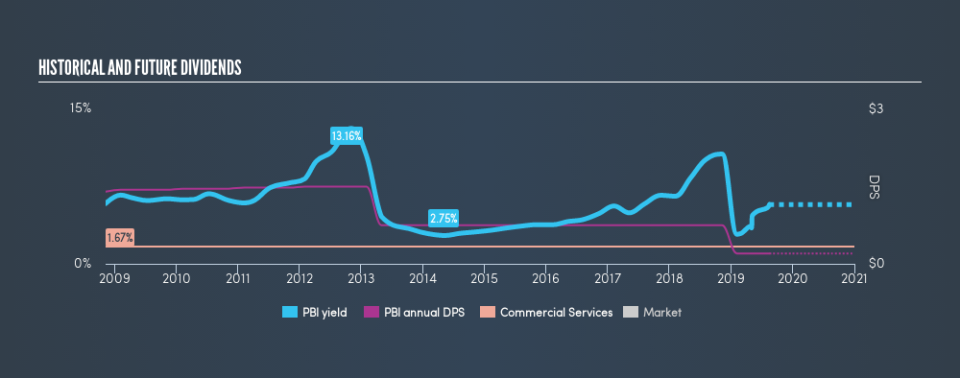Dividend Investors: Don't Be Too Quick To Buy Pitney Bowes Inc. (NYSE:PBI) For Its Upcoming Dividend

Some investors rely on dividends for growing their wealth, and if you're one of those dividend sleuths, you might be intrigued to know that Pitney Bowes Inc. (NYSE:PBI) is about to go ex-dividend in just 4 days. Ex-dividend means that investors that purchase the stock on or after the 22nd of August will not receive this dividend, which will be paid on the 11th of September.
Pitney Bowes's next dividend payment will be US$0.05 per share, and in the last 12 months, the company paid a total of US$0.20 per share. Last year's total dividend payments show that Pitney Bowes has a trailing yield of 5.8% on the current share price of $3.47. If you buy this business for its dividend, you should have an idea of whether Pitney Bowes's dividend is reliable and sustainable. As a result, readers should always check whether Pitney Bowes has been able to grow its dividends, or if the dividend might be cut.
Check out our latest analysis for Pitney Bowes
If a company pays out more in dividends than it earned, then the dividend might become unsustainable - hardly an ideal situation. Pitney Bowes is paying out an acceptable 69% of its profit, a common payout level among most companies. Yet cash flows are even more important than profits for assessing a dividend, so we need to see if the company generated enough cash to pay its distribution. It paid out 93% of its free cash flow in the form of dividends last year, which is outside the comfort zone for most businesses. Cash flows are usually much more volatile than earnings, so this could be a temporary effect - but we'd generally want look more closely here.
While Pitney Bowes's dividends were covered by the company's reported profits, cash is somewhat more important, so it's not great to see that the company didn't generate enough cash to pay its dividend. Cash is king, as they say, and were Pitney Bowes to repeatedly pay dividends that aren't well covered by cashflow, we would consider this a warning sign.
Click here to see the company's payout ratio, plus analyst estimates of its future dividends.
Have Earnings And Dividends Been Growing?
Companies with falling earnings are riskier for dividend shareholders. If earnings fall far enough, the company could be forced to cut its dividend. Readers will understand then, why we're concerned to see Pitney Bowes's earnings per share have dropped 14% a year over the past five years. When earnings per share fall, the maximum amount of dividends that can be paid also falls.
The main way most investors will assess a company's dividend prospects is by checking the historical rate of dividend growth. Pitney Bowes's dividend payments per share have declined at 18% per year on average over the past 10 years, which is uninspiring. While it's not great that earnings and dividends per share have fallen in recent years, we're encouraged by the fact that management has trimmed the dividend rather than risk over-committing the company in a risky attempt to maintain yields to shareholders.
Final Takeaway
Has Pitney Bowes got what it takes to maintain its dividend payments? Pitney Bowes had an average payout ratio, but its free cash flow was lower and earnings per share have been declining. It's not an attractive combination from a dividend perspective, and we're inclined to pass on this one for the time being.
Wondering what the future holds for Pitney Bowes? See what the five analysts we track are forecasting, with this visualisation of its historical and future estimated earnings and cash flow
A common investment mistake is buying the first interesting stock you see. Here you can find a list of promising dividend stocks with a greater than 2% yield and an upcoming dividend.
We aim to bring you long-term focused research analysis driven by fundamental data. Note that our analysis may not factor in the latest price-sensitive company announcements or qualitative material.
If you spot an error that warrants correction, please contact the editor at editorial-team@simplywallst.com. This article by Simply Wall St is general in nature. It does not constitute a recommendation to buy or sell any stock, and does not take account of your objectives, or your financial situation. Simply Wall St has no position in the stocks mentioned. Thank you for reading.

